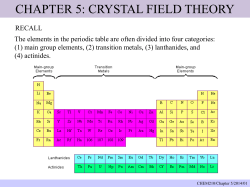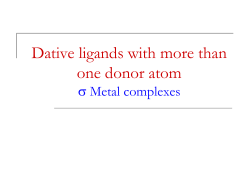
Applications of CFT for Oh Complexes 1. High- and low-spin
Applications of CFT for Oh Complexes 1. High- and low-spin complexes TM ions can contain varying numbers of unpaired electrons in their d orbitals – how can we establish the number of unpaired e-? magnetic measurements: not as straightforward as you might think! Oh complexes for d4 to d7 ions can display different numbers of unpaired electrons, even for the same metal with different ligand sets – depends on: a) size of Δoct b) magnitude of the crystal field stabilization energy (CFSE) for a particular electronic configuration d1 d2 +0.6 Δoct Bary Centre -0.4 Δoct CFSE = -0.4 Δoct = 2(-0.4) = -0.8 Δoct d4 ion case – two possible arrangements: ‘high’ and ‘low’ spin +0.6 Δoct Bary Centre -0.4 Δoct = 4(-0.4 Δoct) + P CFSE = 3(-0.4 Δoct) + (+0.6 Δoct) = -1.6 Δoct + P = -0.6 Δoct P = ‘pairing energy’ made up of: a) exchange energy: electrons with parallel spins experience less repulsion that electrons with anti-parallel spins even if they are in different orbitals (Hund’s rule) b) electron-electron repulsion greatest if spins are paired in the same orbital So, in this case, energies of the two configurations are equal if P = Δoct OR High spin if Δoct < P and Low spin if Δoct > P The magnitude of Δoct and P are similar for 1st row TM so both high spin and low spin complexes ARE actually observed: eg. [Fe(H2O)6]3+ vs. [Fe(CN)6]3- Δoct [Fe(H2O)6]3+ Δoct = 13,700 cm-1 = 35,000 cm-1 [Fe(CN)6]3- H2O is a weak field ligand → high spin complex CN- is a strong field ligand → low spin complex 2. Jahn Teller distortions of d4 and d9 Oh systems Tetragonal distortions (lengthening of either four ‘equatorial’ or two ‘axial’ bonds) of an Oh complex are observed only with high spin d4 or d9 electron counts. Why? eg. [CrF6]4- high spin d4 axial elongation dx2-y2 dz2 dxy dxz dyz • distortion occurs when there is a partially filled degenerate set of orbitals because this breaks the degeneracy allowing more electrons to occupy the lower energy orbitals • with axial elongation along z, orbitals pointed along z are relatively stabilized compared to those in the xy plane so it is better for electron to occupy the dz2 orbital of the (formerly) eg set (if e- goes in dx2-y2, equatorial elongation will happen instead) Similarly for the d9 configuration: axial elongation dx2-y2 dz2 dxy dxz dyz However, distortions are not usually observed in d5 system even though there is a partially occupied t2g set – why not? • t2g set do not point directly at a ligand so the gain in stabilization caused by distortion is very small CFT for 4-coordinate complexes Square planar complexes – related to Jahn Teller distortions of Oh complexes d8 complexes Oh axial elongation Square Planar dx2-y2 dx2-y2 dz2 dxy dxy dxz dyz dz2 dxz dyz • Square planar complexes are always diamagnetic (spin paired) because the difference in energy between dxy and dx2-y2 is large Tetrahedral (Td) crystal fields How does a Td crystal field split the d orbitals? This is MUCH harder to see visually but we again get two sets of orbitals: dxz dyz dxy t2 e dx2-y2 dz2 • hard to see but dx2-y2 and dz2 point between the ligands more than do dxz, dyz and dxy so they are relatively stabilized • the tetrahedral crystal field (Δt) splitting is less than octahedral splitting (Δoct) because no orbitals point directly at the ligands: Δt = 4/9 Δoct CN4, d8 structural preferences: Td vs. SqP Td SqP +1.2 +1.0 +0.8 E N E R G Y +0.6 +0.4 +0.2 0 -0.2 -0.4 -0.6 larger fields favour SqP over Td: [Ni(CN)4]2- is SqP BUT [NiCl4]2- is Td [PdCl4]2- is SqP BUT [NiCl4]2- is Td 2nd and 3rd row d8 complexes are virtually always SqP easily distinguishable by magnetism because Td is paramagnetic (unpaired electrons) while SqP is diamagnetic (paired electrons) Crystal field splittings for other geometries (Fig. 21.11 H&S 3rd Ed): Which d count is most likely to favour a square pyramidal structure over a trigonal bipyramid? d4 would be a good bet and some Fe(IV) compounds do adopt this geometry What does the fact that the ferrate ion [FeO4]4- distorts from tetrahedral tell you about the electron configuration? If it distorts it is presumably doing so for electronic reasons and that suggests a Jahn Teller distortion. For this to occur it must be high spin because the low spin complex has a filled e set.
© Copyright 2025











